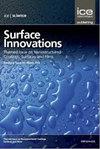芳纶织物的着色及抗菌处理综述
IF 3.5
4区 材料科学
Q3 CHEMISTRY, PHYSICAL
引用次数: 1
摘要
芳纶织物/纤维(AF)具有低密度、高比强度、高比模量等突出的综合性能,广泛用于国防服装。AF的特定着色效果需要不同的染料和化学物质。AF由于其非常结晶的结构和显著的致密性,相对难以染色。超临界二氧化碳、微波辐照、液氨、紫外处理、共聚合、高温、载体法、臭氧处理等技术已被应用于AF的染色,其中一些工艺在耐洗、耐摩擦、耐光等方面表现出优异的染色性能。AF也经常在恶劣的环境中使用,不能及时清洗;在其表面生长的细菌可能会造成健康问题,因此具有抗菌特性的AF非常受欢迎。目前已有许多针对房颤的抗菌治疗,以发展对革兰氏阳性和革兰氏阴性细菌的保护。用银纳米粒子(AgNPs)原位处理AF显示出较高的抗菌活性。然而,目前还没有对AF的着色度和抗菌活性进行讨论的文献。因此,本文综述了不同染料和纳米颗粒对AF的着色度和抗菌活性的影响。本文章由计算机程序翻译,如有差异,请以英文原文为准。
Coloration and antibacterial treatment of aramid fabric: A comprehensive review
Aramid fabric/fiber (AF), which possesses outstanding comprehensive qualities such as low density, high specific strength, and high specific modulus, is widely used for dresses of defense applications. Different dyes and chemicals are required to give the specific coloration effect of AF. AF are relatively difficult to dye due to their very crystalline structure and remarkable compactness. The different techniques, including supercritical carbon dioxide, microwave irradiation, liquid ammonia, ultraviolet treatment, co-polymerization, high temperature, carrier method, and ozone treatment, have already been utilized for the dyeing of AF. Among the processes, some of them show excellent dyeing performances in color fastness to wash, rubbing, and light. The AF also frequently used in harsh environments and cannot be cleaned in a timely manner; bacteria that develop on their surface might pose a health concern, making AF with antibacterial properties are extremely desirable. There have been a number of antibacterial treatments for AF to develop protection against gram-positive and gram-negative bacteria. The in-situ treatment of AF using silver nanoparticles (AgNPs) showed a high level of antibacterial activity. However, there are no reviews that discuss the coloration and antibacterial activity of AF. Therefore, this review summarized the coloration and antibacterial activity of AF using different dyes and nanoparticles.
求助全文
通过发布文献求助,成功后即可免费获取论文全文。
去求助
来源期刊

Surface Innovations
CHEMISTRY, PHYSICALMATERIALS SCIENCE, COAT-MATERIALS SCIENCE, COATINGS & FILMS
CiteScore
5.80
自引率
22.90%
发文量
66
期刊介绍:
The material innovations on surfaces, combined with understanding and manipulation of physics and chemistry of functional surfaces and coatings, have exploded in the past decade at an incredibly rapid pace.
Superhydrophobicity, superhydrophlicity, self-cleaning, self-healing, anti-fouling, anti-bacterial, etc., have become important fundamental topics of surface science research community driven by curiosity of physics, chemistry, and biology of interaction phenomenon at surfaces and their enormous potential in practical applications. Materials having controlled-functionality surfaces and coatings are important to the manufacturing of new products for environmental control, liquid manipulation, nanotechnological advances, biomedical engineering, pharmacy, biotechnology, and many others, and are part of the most promising technological innovations of the twenty-first century.
 求助内容:
求助内容: 应助结果提醒方式:
应助结果提醒方式:


